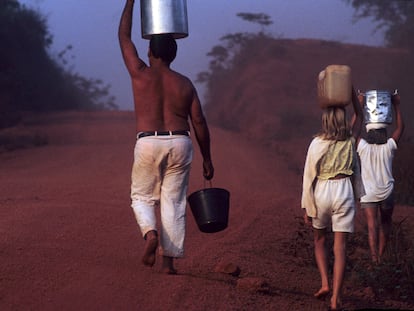Dr. Kavita Singh: ‘Climate change is altering patterns for dengue fever and other diseases. Before, we didn’t have as many cases, or as many deaths’
On Friday, Spain’s Princess of Asturias Foundation presented an award to an organization that researches treatments for neglected diseases. The group’s director says that combating these diseases will benefit the entire world, not just the countries that currently suffer from them

Diseases don’t respect borders, and neglected diseases don’t only affect people living thousands of miles away. The fact that they are called “neglected” does not mean that those with the money and the power to transform global health priorities should ignore them. This is the message of Indian scientist Dr. Kavita Singh, the South Asia Director at the Drugs for Neglected Diseases initiative (DNDi), who on Friday accepted the Princess of Asturias Award for International Cooperation in Oviedo, Spain. The organization is well-recognized for its work in the research and development of new “affordable and easy-to-use” treatments for people suffering from one of these 20 neglected ailments — a total of 1 billion people around the world, according to the World Health Organization (WHO).
The list of neglected diseases, most of them primarily affecting impoverished tropical areas, includes two pathogens that represent a major focus of the 54-year-old Indian scientist’s work: visceral leishmaniasis, a parasitic disease, and dengue fever, which is transmitted by mosquitos. During her 20 years working with the DNDi, Singh has celebrated some small victories, but she prefers to focus on what remains to be done. “Our work will only be complete when a patient in a remote village in a tropical country can get a diagnosis and access the best medicine available for his or her disease, without having to travel long distances,” she told EL PAÍS in the following interview, conducted over telephone.
Question. Are neglected diseases synonymous with diseases that only exist in far-away places?
Answer. No, definitely not. I personally feel that they’re not where they need to be on the global health agenda. Nor do funders give them the importance they should. Hopefully this award will serve to put the focus on these ailments. Many of them are diseases that are heavily influenced by climate change, and we know they’re going to transform in the coming years. Treatments for neglected diseases benefit everyone, not just the regions that are suffering from them today.
Q. Can you give an example of the impact of climate change on the evolution of these diseases?
A. Patterns of dengue and other diseases are altered by climate change, for example. We used to not have as many cases or as many deaths in our South Asian region. In Bangladesh, there have been more than 1,000 dengue deaths this year. These are numbers we haven’t seen in decades. The same is happening in Sri Lanka and Pakistan, where thousands of people are infected. Health systems collapse in the face of high number of patients, and we inevitably lose some patients.
Q. DNDi recently formed the Dengue Alliance with institutions from several countries, such as India, Thailand, Malaysia and Brazil, to accelerate research and implementation of a treatment for this disease over the next five years. Is this also an example of the effectiveness of South-South cooperation?
A. The knowledge, experience and years of work in the fight against dengue all come from the countries of the South, because that’s where most of the sick people are, so the trials must take place in these countries. It’s not that we want to leave out the countries of the North — it’s an initiative to work together, move faster and achieve a real treatment for this disease, because for now, one does not exist. Currently, we are limited to mitigating the pain and symptoms of patients. We must not forget that today, dengue occurs mainly in tropical countries, but with climate change, the vector may change and the presence of the disease as well.
Q. In the 20 years that DNDi has existed, have treatments for these diseases and their accessibility improved in South Asia?
A. Each disease is different. Some diseases are under control now, and have been removed from the list of public health priorities. For others, treatments exist, but populations don’t have access to them. And then for others, the best treatment still does not yet exist, as is the case with Chagas disease, for example. In the case of sleeping sickness [Human African trypanosomiasis], DNDi has done incredible work with a drug that cannot yet be applied to all versions of the disease. Most of these 20 neglected diseases attack already impoverished communities and deplete them even more. It’s a hellish cycle. That’s why our work will only be complete when a patient in a remote village in a tropical country can get a diagnosis and access the best medicine available for his or her disease, without having to travel long distances.
Q. At the moment, what are India’s biggest challenges in the fight against neglected diseases?
A. We always talk about regions, not countries, because diseases and vectors don’t respect borders. In the past 20 years, we have made a lot of progress in the treatment of visceral leishmaniasis, also known as kala-azar. Before, we had three treatments, and we conducted a study to compare their efficacy. What we saw was that a single dose of one drug, liposomal amphotericin B, showed very high efficacy and should be the first choice. This recommendation was included in national programs and has transformed the situation. Above all, it has reduced the number of deaths. In India, for example, there were 33,000 cases per year in 2011 and now there are around 800. This disease presents complications, and years later, some patients can develop another variant called post-Kala-Azar dermal leishmaniasis (PKDL), which causes serious skin lesions. A clinical trial has now been completed, and we are closer to implementing a treatment that is simpler and doesn’t have side effects. Limiting the disease and treating it early on also helps curb the social marginalization suffered by those affected, especially children and women.
Q. Are women more affected by neglected diseases?
A. From a strictly medical point of view, no, but women have a disadvantage when it comes to accessing medications, and in general don’t have it as easy as men, in many cases. In addition, women are more afraid to make their disease publicly known, due to the pressures of the societies in which they live. For example, if a girl or a woman has skin lesions, it is not so easy for them to leave their home and ask for treatment. This is why, for us, education is nearly as important as the adoption of effective treatments.
Sign up for our weekly newsletter to get more English-language news coverage from EL PAÍS USA Edition
Tu suscripción se está usando en otro dispositivo
¿Quieres añadir otro usuario a tu suscripción?
Si continúas leyendo en este dispositivo, no se podrá leer en el otro.
FlechaTu suscripción se está usando en otro dispositivo y solo puedes acceder a EL PAÍS desde un dispositivo a la vez.
Si quieres compartir tu cuenta, cambia tu suscripción a la modalidad Premium, así podrás añadir otro usuario. Cada uno accederá con su propia cuenta de email, lo que os permitirá personalizar vuestra experiencia en EL PAÍS.
¿Tienes una suscripción de empresa? Accede aquí para contratar más cuentas.
En el caso de no saber quién está usando tu cuenta, te recomendamos cambiar tu contraseña aquí.
Si decides continuar compartiendo tu cuenta, este mensaje se mostrará en tu dispositivo y en el de la otra persona que está usando tu cuenta de forma indefinida, afectando a tu experiencia de lectura. Puedes consultar aquí los términos y condiciones de la suscripción digital.
More information
Archived In
Últimas noticias
Most viewed
- Oona Chaplin: ‘I told James Cameron that I was living in a treehouse and starting a permaculture project with a friend’
- Sinaloa Cartel war is taking its toll on Los Chapitos
- Reinhard Genzel, Nobel laureate in physics: ‘One-minute videos will never give you the truth’
- Why the price of coffee has skyrocketed: from Brazilian plantations to specialty coffee houses
- Silver prices are going crazy: This is what’s fueling the rally










































